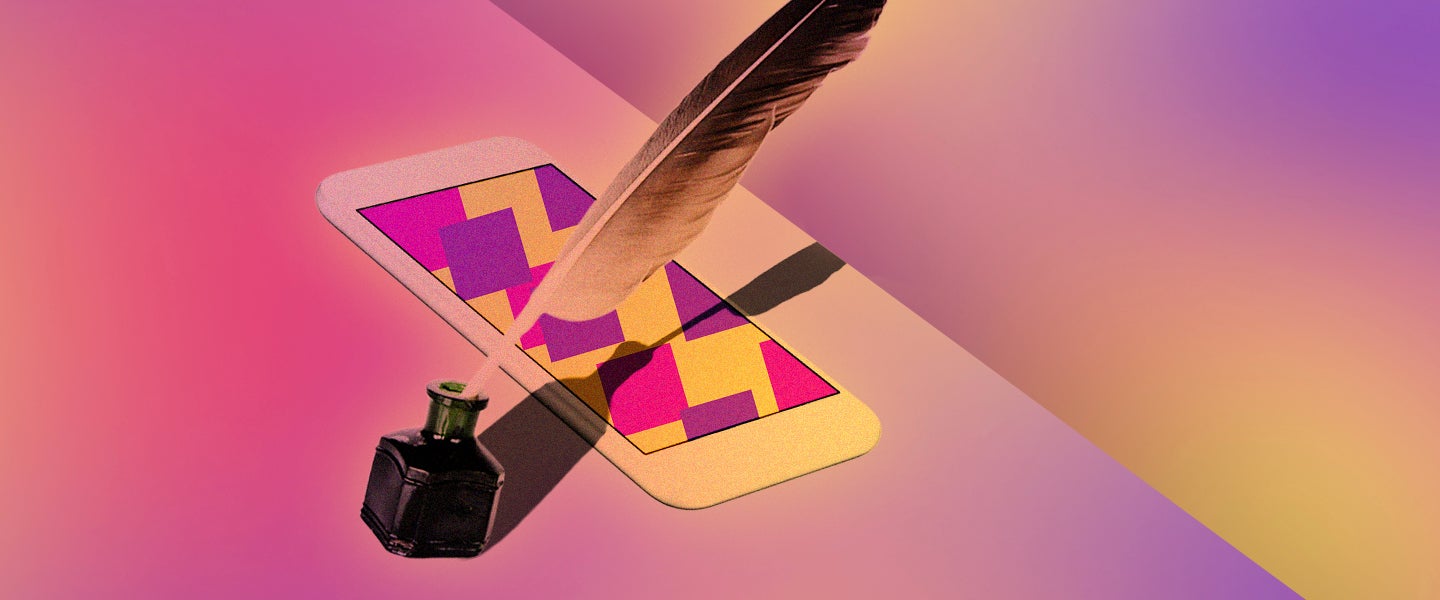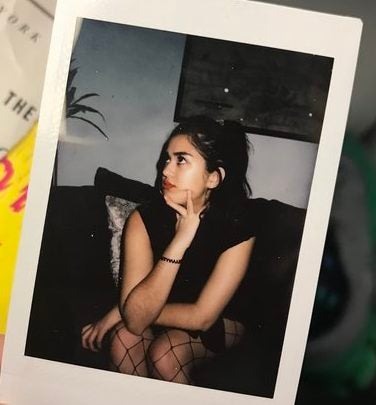There’s a uniformity to the grid of an Instagram poet, the same way there’s a uniformity to the grid of a skincare girl or a yoga obsessive. Curation is a necessity for building any kind of following online and the formula, for poets, is relatively simple: A stanza or two floating on a not-quite-white background, seemingly ripped fresh from a typewriter or hot-off-the-presses chapbook.
If you’re glancingly familiar with the way straight men tend to post stark, “self-serious” brotography on Instagram, you’ll understand why the grids of male Insta-poets tend to be sparser than their female counterparts. They love simple formats devoid of selfies or personal affects, while women tend to have grids festooned with dried flowers and personal photos, their poems arranged as the centerpiece of a tableau not unlike the traditional influencer flat lay.
But all Instagram poetry shares similar thematic and structural similarities. The poems tend to be about love or heartbreak, because that’s the kind of relatable material that hits home (and gets the most engagement). They’re also almost always short, sometimes only a line or two, because people don’t go on Instagram to read.
The style is famously easy to replicate and has been mocked endlessly by professional critics, on Twitter and likely in the Instagram DMs of anyone who knew an Insta-poet in high school. Rupi Kaur, a 27-year-old poet whose collections Milk and Honey and The Sun and Her Flowers were both New York Times best sellers, is the most widely scrutinized and parodied Insta-poet (although, to be technical, she blew up on Tumblr first). That’s probably because her most famous poems hinge on lines like “i am a museum full of art / but you had your eyes shut.”
The fact that she’s a young woman of color whose work often deals with subjects like trauma and doomed relationships also factor into why she’s controversial in the glaringly white and mostly male English poetry canon. “There was no market for poetry about trauma, abuse, loss, love and healing through the lens of a Punjabi-Sikh immigrant woman,” she told The Guardian in a 2016 interview. “Ten years ago, who was going to embrace the story of a young brown woman?”
white ppl try 2 write poetry like:
my pale hands
on her pale skin
we shattered
cigarettes— fanta (@GOTHPVNK) October 18, 2015
he gave me
red flags
he did not know
I am a bull
– rupi kaur
— shonda rhimes wrote crossroads (@jersing) November 14, 2019
Lol these are so easy pic.twitter.com/j4mTNqBCTV
— Mark Scialabba (@MarcusGroovy) August 29, 2017
Deriding Instagram poets has gradually fallen out of style, especially as the platform has transformed into a solid path to mainstream success. Kaur has 3.8 million Instagram followers; Atticus, an anonymous poet from Canada, has 1.3 million; and R.M. Drake, a poet from Miami, boasts 2.1 million. Then there are writers like Tyler Knott Gregson (361,000 followers) and Lang Leav (532,000), both early Tumblr entrants into the Instagram poetry scene who have since published multiple books that have sold hundreds of thousands of copies. This new wave of poetry has been credited with boosting cultural engagement on an international scale. According to a report by The Atlantic, poetry was one of the fastest growing genres in publishing as of late 2018 due in part to the distinct rise in American interest, hitting a nearly 20-year peak in popularity at 28 million readers.
The male poets I speak with say that despite the fact that women make up the majority of the current scene (one estimated 70 percent of his fellow internet poets were women, another placed the figure closer to 80 percent), they don’t feel their work receives a different reception because of their gender. “I really don’t see the sex of the poet affecting the reception of the work,” says Jon Lupin (@the_poetrybandit), a Canadian poet with 168,000 followers who’s been active in Instagram’s poetry community since 2014. “I receive a lot of support from my fellow female poets as well.”
Lupin is currently writing full-time, with one self-published poetry collection and two collections published by a Macmillan imprint, Castle Point Books, already under his belt. He credits Instagram fully for his success. “When Macmillan reached out, I had maybe over 100,000 followers, and they’d seen a few pieces of mine,” Lupin says. “One of the poets they’d signed up [Alfa Holden] recommended me. It’s rare that a publishing house offers a contract to somebody, and I didn’t have to do anything for it. I just had to be myself and tell my story.”
JH Hard (@hardpoetry), who self-published his first book of poetry and is working on a second with a “tiny, little publisher” that he connected with via Instagram, has 235,000 Instagram followers. Like Lupin, he also estimates that around 80 percent of his readers are women, mostly based in international locales like India and Indonesia. He adds that he thinks his work is perceived as more of an outlier based on its content and his gender. “Women are more sought after as poets,” Hard says. “Women are expected by society to fit the poet mold more, so sometimes I’m overlooked or get reactions of surprise from people. That’s about it, though.”
Hard used to type his lines out on a typewriter when he created his Instagram account 18 months ago, but it was inefficient. He couldn’t lug the machine to his day job in advertising, and he tries to post around noon on a daily basis. Now he achieves the effect, along with the “pinkish-purple” tint I don’t notice until he points it out, with Photoshop. (Lupin actually owns four typewriters. But none of them are working right now, so he’s using an app to mimic the look in the meantime.)
If the men of Poetry Instagram are afraid of the kind of backlash directed at the “hated” Portland poet Collin Andrew Yost, who online commenters eviscerated in 2017 (rightfully or wrongly, depending on how you feel about the mob mentality on Twitter, lite misogyny and wasting cigarettes in the name of digital art), they don’t talk to me about it. They also don’t let it stop them from posting content that, at first glance, could easily be confused with Yost’s work, which got him branded as a “woman hater” and a “master class in who gets to be mediocre.” (Yost declined my interview requests.)
More largely, not every poet is amenable to the pressures that the pursuit of Insta-fame (and real-world publishing “success”) confer. Will Bortz (@willbortz), who works as an editor at a small publishing house, says his follower count peaked somewhere in the upper 8,000 range, but that the number has dwindled down to around 7,500 since he became less active on the platform because of the necessity to write material specifically for it. “When I was writing for Instagram, there wasn’t really much there,” he tells me. “It was a pretty word and a little neat sentence, but it wasn’t saying anything. I wasn’t writing every day. There was no schedule. I was just like, ‘I gotta get a post up today! That’s my thing!’ It was like a part-time job that you make no money from.”
Not to mention, being an Instagram poet comes with the added hassle of being your own social media manager. In particular, Insta-poets are insanely easy to contact, at least compared to other internet figures whose follower counts creep up into the seven-figure range (they often have email addresses linked alongside open DMs). That said, they all mention communication with fans as a big source of motivation.
For example, Lupin, who has written extensively about his struggles with alcoholism and sobriety, sends copies of My Sober Little Moon, his self-published first book, to people who reach out to him to talk about addiction or ask for help. “I tell them what kind of recovery groups work for me,” Lupin says. “In some cases, I’ve helped people get into recovery houses or halfway houses and out of abusive situations. I’ve got a really long list of Instagram accounts of people I’ve helped that I reach out to once in a while and say, ‘Hey, how’s it going?’ That makes it all worth it.”
Along those lines, per Lupin, things have grown more empathetic within Poetry Instagram over the last few years. Because when he first started posting his writing there in 2014, infighting was a regular occurrence. “There were a lot of people who would personally attack other poets,” he says. “I still have some people blocked from back then. That’s not there anymore. People are very supportive now; it’s a completely different feel.” These days, Lupin says the biggest issue Instagram poets face is stolen content, an epidemic he blames on a decrease in “conscience.”
As for using Instagram to meet women — because it’s the first thing everyone asked me when I talked about this story — the male poets I interviewed swore nothing romantic has ever bloomed from their presence on the platform. Bortz was married for a year before he even started posting his work. Lupin began posting in tandem with his now-ex wife around four years ago, and he’s only been single for around three months (he “wouldn’t rule it out” if it happened, it just hasn’t). Hard, who says most of his friends don’t know that he’s the person behind his account, laughed at the idea of picking someone up on the strength of his online popularity. “Like who?” he jokes.
He isn’t even that thrilled with the famous women in his fanbase. “I’m not honored when Khloe Kardashian posts my poem, because you’d rather Natalie Portman post your poem,” he tells me. “But I’ve gotten a lot of traffic from that kind of stuff.”
In terms of the future, Bortz has since archived most of his written-for-Insta posts and shifted his focus to getting work published in literary magazines, building up the friendships he’s made online and cultivating his craft in the real world. But he doesn’t begrudge Instagram poets, or the people who love their work. “Someone who find this little bit of writing, and it affects them? That’s great. What’s wrong with that?” he says.
Hard, on the other hand, is skeptical about the quality and staying power of Instagram poetry. He doesn’t necessarily feel judged as a man in the Instagram poetry scene, but he does feel some resentment from his peers in the poetry community about the breadth of exposure his work gets on the platform — which he kind of agrees with.
“Anyone who says Instagram poets are bullshit, they’re like 95 percent correct, and I don’t ever fault them for that,” he tells me. “If you interview anybody else, they’re gonna be like, ‘Poetry is anything you want it to be.’ No it’s not. Poetry is when talented people spill their guts in a way that nobody has spilled their guts before. Not everyone can do that. So it cheapens writing in general to think that anything can be a poem.”

